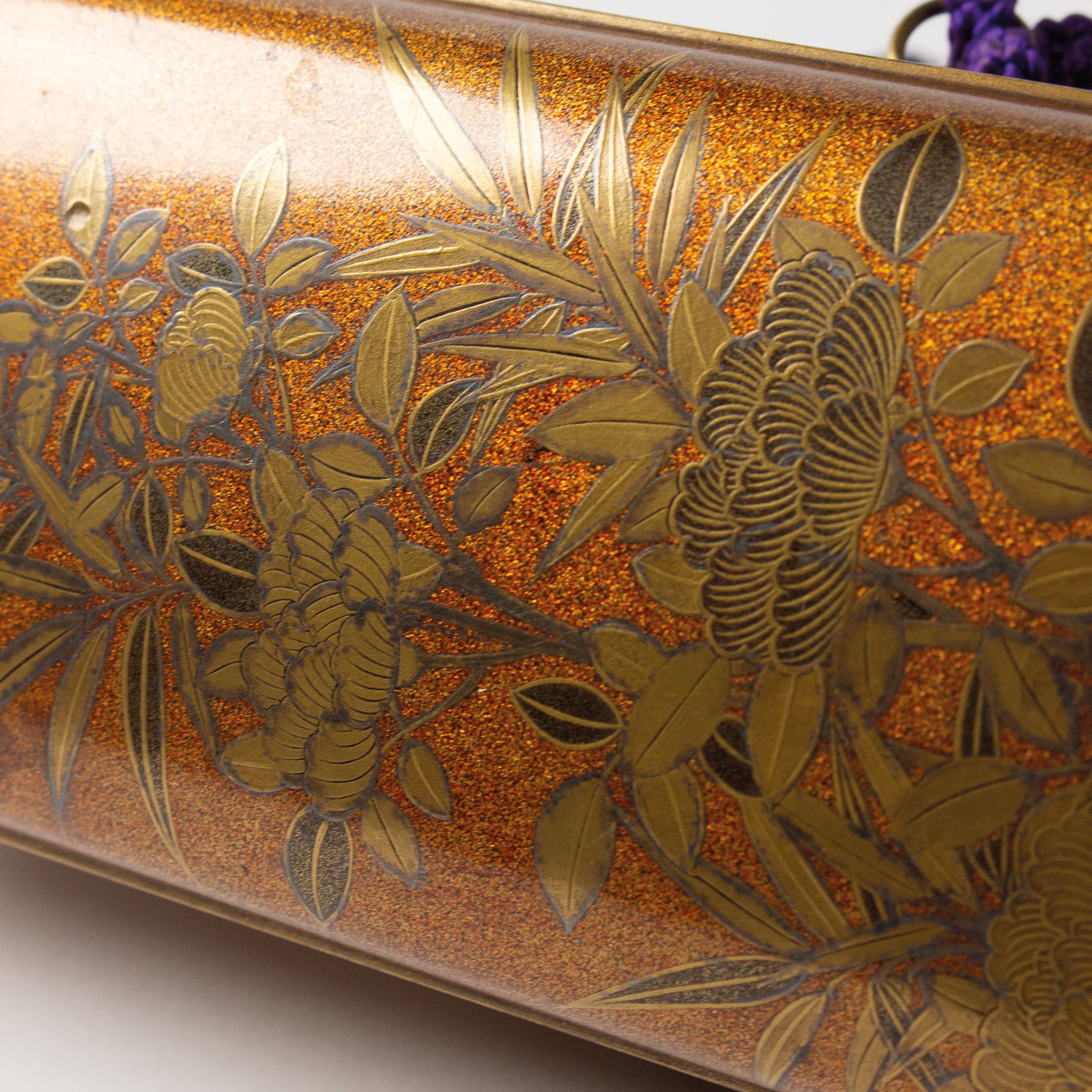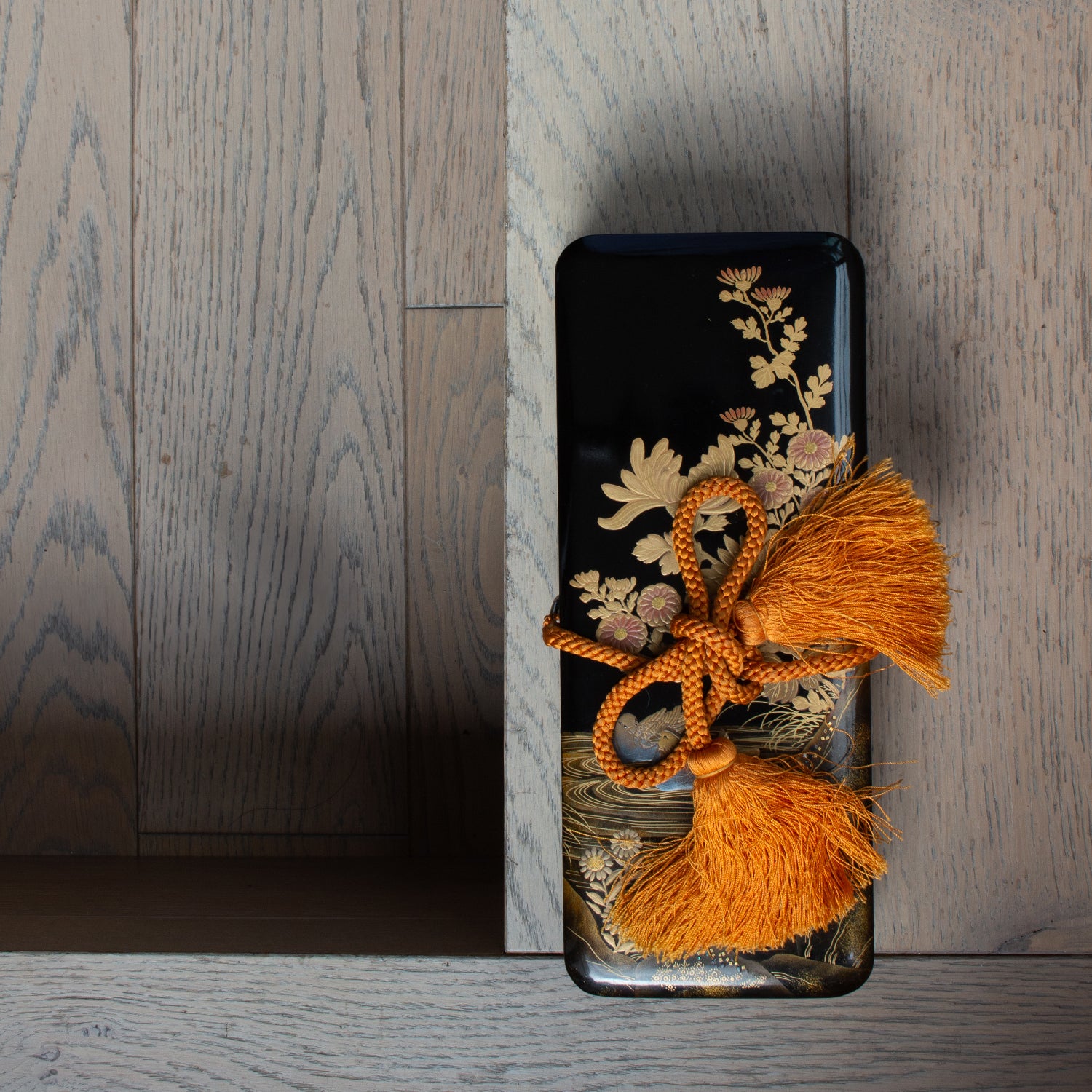



















Japanese Tanzaku box in urushi lacquer and gold powder makie
Antique tanzaku box (late 19th century) of traditional Japanese craftsmanship in wood on which multiple layers of natural urushi lacquer have been applied and displaying a superb decoration of peonies and bamboo.
The intricate patterns of the decoration are made using various makie (gold powder) techniques: hiramaki-e 平蒔絵 (bas-relief lacquer) and nashiji 梨子地 (sprinkled gold lacquer, which covers the entire background of the decoration) in different shades of gold. The interior of the tanzaku-bako is made of black urushi lacquer. The decorations are extremely fine and delicate, making it a high-quality piece. This box is antique, late 19th century (late Edo or early Meiji era) and is in good condition except for a few visible signs of the passage of time: some traces of wear, small chips and discoloration of the gold in some places, which are visible in the photos. This is an antique that has survived the ages but nevertheless retains all its beauty and rarity.
Tanzaku-bako are boxes traditionally used in Japan to store poems. They are tied with a braided cord, here in a very beautiful contrasting purple.
It comes with its wooden protective box. This is a unique piece made according to the rules of the art of deep black urushi lacquer and gold powder makie, a magnificent and precious object very representative of exceptional Japanese know-how.
|
|
JAPAN |
|
|
(box only) L24cm x D7.2cm x H6.8cm |
| WEIGHT | (total) 630gr |
| COMPOSITION |
|
| ERA |
late Edo era (1603-1868)/early Meiji era (1868-1912)
|
| STATE |
In good condition considering its age, but some signs of the passage of time: traces of wear, small chips and discoloration of the gold in some places (see photos).
|
KNOW-HOW
Traditional Japanese lacquer, urushi, comes from the sap of the lacquer tree (Rhus Verniciflua), which flows after incision of the bark. It is a very precious material, a tree will give a maximum of 200ml of sap in its life, which is worked by specialized craftsmen. It takes many operations, slow and meticulous, and several months of work to bring real lacquer objects to life. It is the oldest craft in Japan! Initially used to protect and waterproof objects, this immutable craft has become an art of extreme sophistication. If you want to know more about the art of Japanese lacquer, you can read our dedicated article > .
DELIVERY
Delivery
Free delivery in metropolitan France for purchases over €150. Orders are generally sent within 2 working days, except in special cases announced in the banner at the top of the site.
Precious items are wrapped in beautiful cloth, beautifully tied in the precious art of Korean pojagi. Some exceptions apply, especially if the items are bulky. Learn more >
Detailed information on deliveries is available via this link >
Your invoice will be sent by email
Payment methods
By card (Stripe operator): Visa, MasterCard, Discover, American Express.
Secure card payment with 3D Secure.
By PayPal, Apple Pay, Google Pay and Shop Pay
Returns and exchanges
14 days to change your mind.
CARE INSTRUCTIONS
Clean with a very soft cloth to avoid scratches, soaked in a little warm water if necessary (never soak your lacquer objects). No microwave, dishwasher, dryer. Do not expose to direct sunlight for a long time (risk of discoloration). If the atmosphere is very dry and very hot, and to avoid the risk of cracking, you can place a glass filled with water next to your lacquer object.
Choose options





















The art of wrapping
The exceptional items are wrapped in a beautiful fabric beautifully knotted using the little-known art of Korean pojagi and decorated with a delightful maedup (Korean ornamental knot). Details and conditions >





